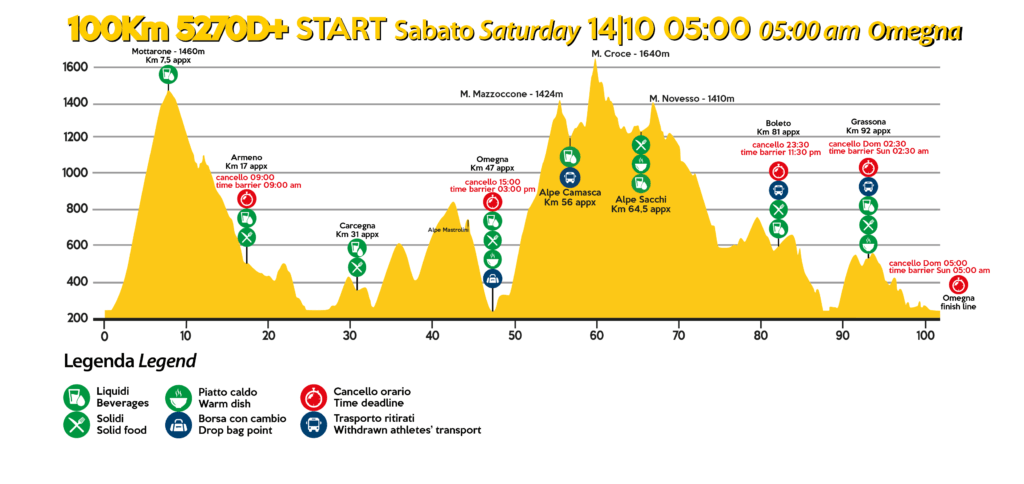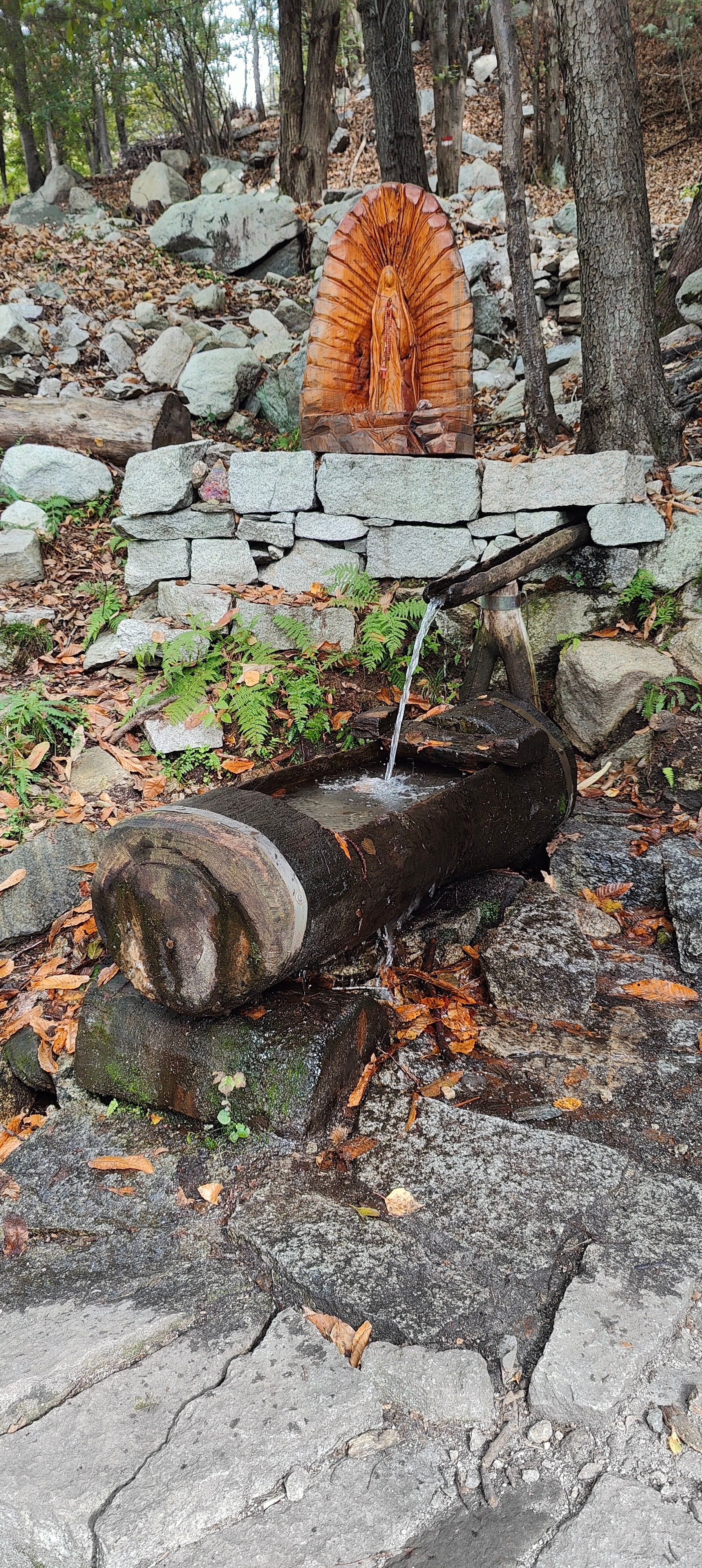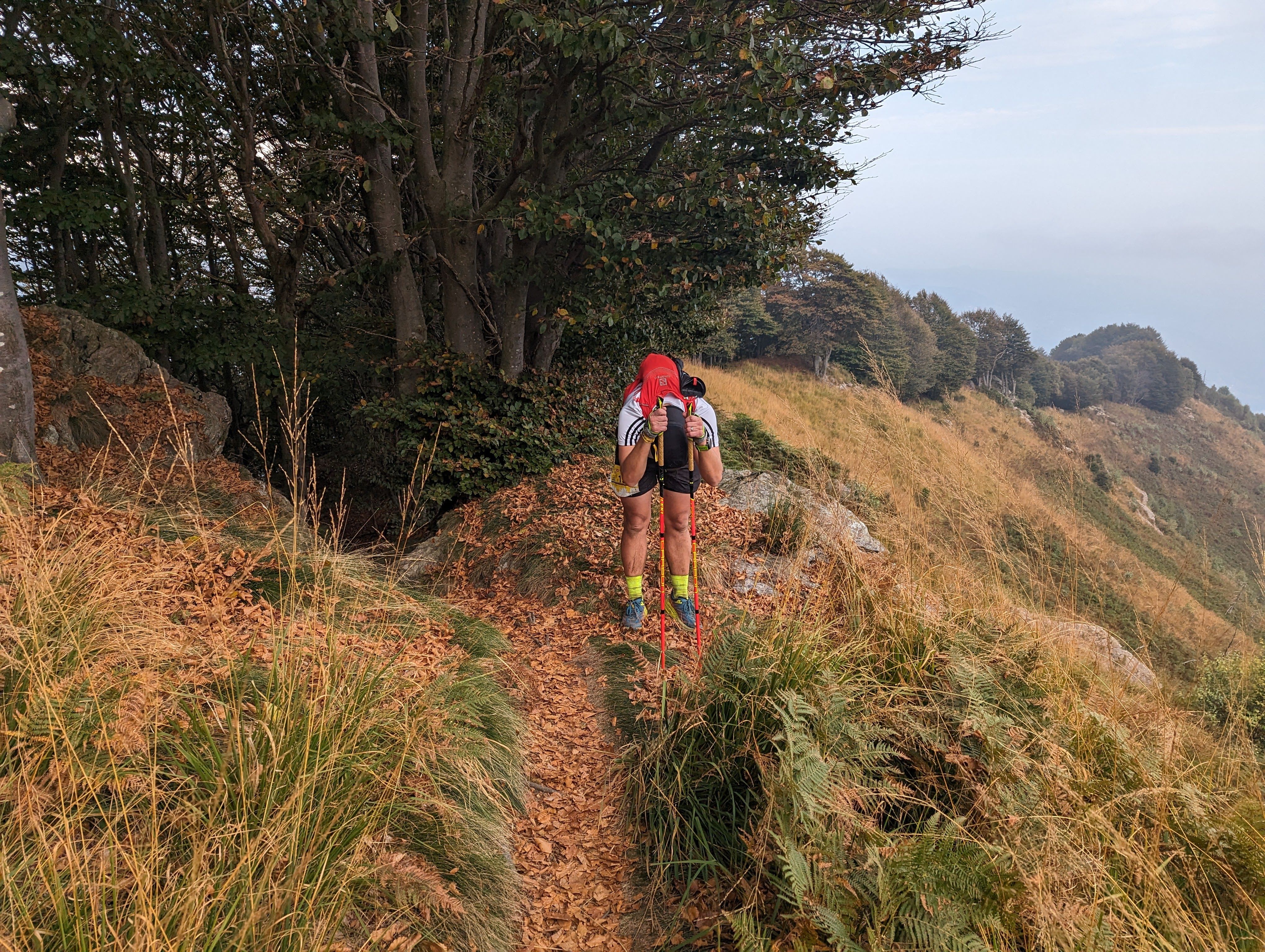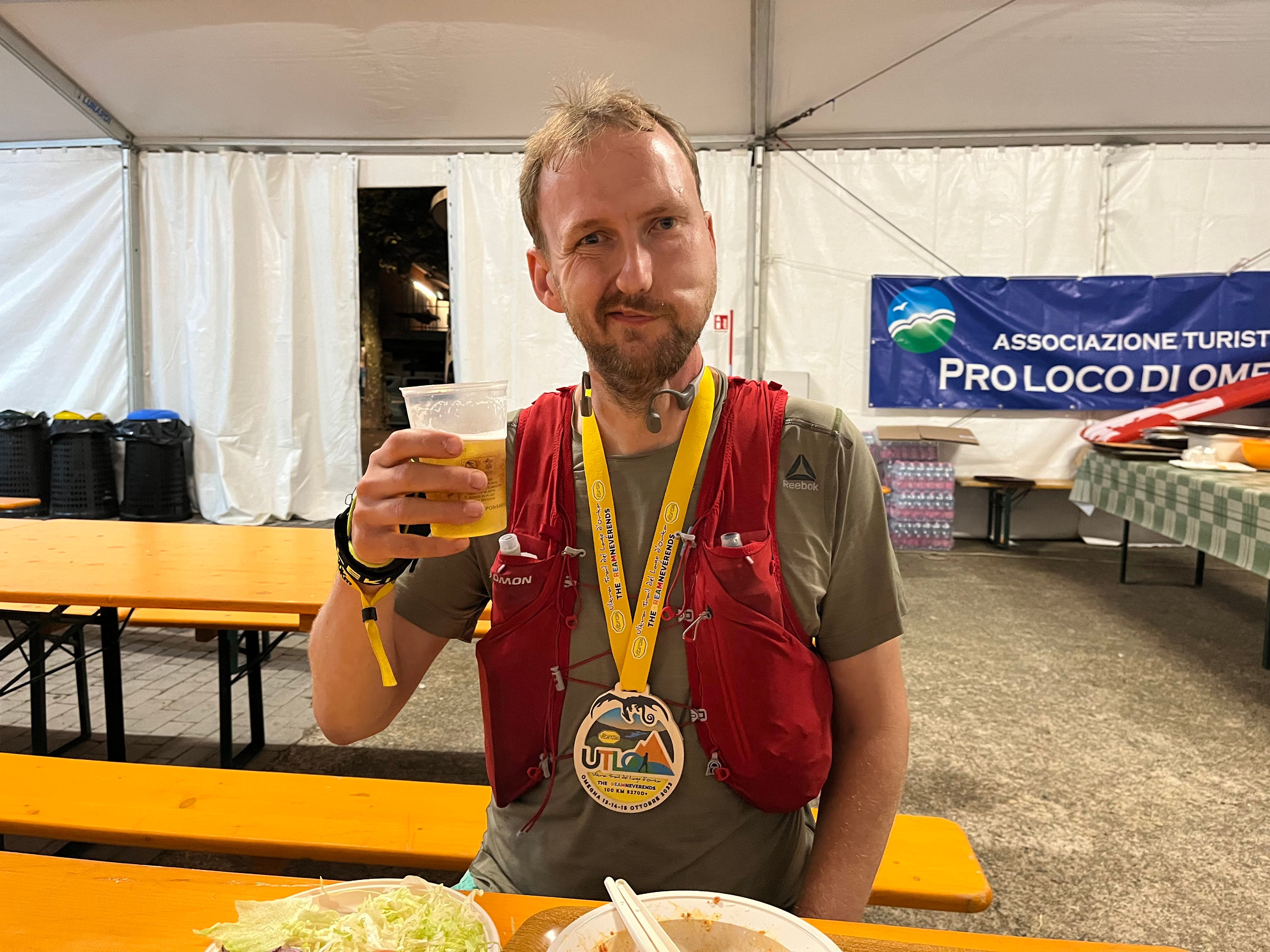Race Information
- What? Lake Orta 100k race report
- When? October 14, 2023
- Distance: 100 km
- Where? VibramUTLO Village, lungolago Gramsci, Italy
- Website: Lake Orta 100km
- Strava Activity: Strava
- Finish Time: 22 hours 40 minutes
Prologue
2023 promised to be a challenging year, unrelated to running. My first child was due in late May. Simultaneously, we were going through a process to sell the company we’d built over the past 15 years.
Naturally, I still wanted to take part in a long run. But it would be very selfish to try to disappear for over a week again when the baby was just a few months old. So, I wondered if I could combine my desire to do a long run with a family trip to Italy, so that my Italian fiance could visit her family and they could spend some time with the baby.
After browsing the WSER qualifiers, I quickly settled on the Lake Orta 100k as a likely candidate. It’s fairly unusual to have a 100k event as a qualifier for WSER, which was a clue that Lake Orta was a tough race.
I quickly roped in Dan, and suggested we make it a double family trip. Later we added Phil to the mix too. We’d get a big Airbnb overlooking the lake, it’d be very relaxing. Win win!
Event preparation
The Lake Orta 100k is a mountainous race in the north of Italy. It starts and finishes in the town of Omegna, which is on the northern-most tip of the lake. The course is effectively a figure of eight around the north of the lake and into the mountains surrounding it. It has around 5300m of ascent over its 100km, which makes its average gradient considerably steeper than Bear 100 (which I completed in 2022). The cut off is 24 hours.
I couldn’t find any race reports from the 100k race online. This is the primary reason for writing this report actually. There are a few YouTube videos, but nothing that really gave us a good sense of what to expect. The videos did show people in all variety of warm weather, cold weather and wet weather clothing, so it looked like a fairly typical mountain race.
Like many European races, you need to get a medical certificate from a doctor before you’re allowed to take part. I’d come across this before when doing the Everest Marathon, but never in any UK or US 100 milers. GPs in the UK are apparently unwilling to sign such medicial certificates, so services have sprung up online where you can get one for a fee. We used Sports Medical Certificates, which cost a pricey £75. At least we had the certificate within a couple of days.
The website listed a few items of mandatory kit (rain jacket, survival blanket and a phone), plus a lot of recommended kit. But a few days before the race they emailed to say that there was no mandatory kit any more and there would be no kit checks.
Arrival and the days before
Driving from Milan up to Lake Orta is pretty dull until you get near to the lake, when it rapidly becomes terrifying. Enourmous sheer rock faces appear from nowhere, sometimes with houses inexplicably sat atop them. We wondered if we’d have to go to the tops of these (it turns out we’d go a lot higher than the ones we saw on the drive).
Our Airbnb was in a small village named Brolo, about 5 minutes drive from Omegna. This meant that we lacked the amenities of Omegna, but it was a large property in a quiet area (apart from the many dogs barking). You’d certainly need a car if you stayed outside of Omegna.
Two days before the race we did a little 5-6km shake out run near our house. This would take in 3km of the race, right near the end. We expected this would be pretty flat and easy as it was right next to the lake. Instead it was hilly and technical, with roots and stones everywhere.
Later that day we hiked a 4km “gnome trail” near Omegna, which we assumed was very child friendly thanks to all the gnomes. Again, we were met by a very technical trail that took us hours with two small children. At the top of the gnome trail was an excellent lookout point over the lake and a mountain hut, with very hospitable people running it. They told us that this was the most technical part of the course (it wasn’t), so we shouldn’t worry (we did). We also discovered the fresh mountain water taps there too. Ice cold, fast flowing and safe to drink. These would be a great help later.
We also discovered some unexpected guests in our Airbnb - scorpions! First I found one in our room, then Helen found one in her room, and then Helen found one in her bed!

Team planning session
Sitting on our terrace overlooking the lake, we wanted to make a pacing plan. We certainly weren’t going for gold here, but we wanted to send some bounds that we could aim between. We filled out all of the aid stations and cutoffs in a spreadsheet. But with such steep ascents and no knowledge of the terrain, we clearly couldn’t do something as crude as eveny split it. Instead, we borrowed a technique from Ian and looked up past finishers on Strava. We found the prior year’s results, looked for some finish times that were around where we wanted (22 hours ish), and looked for some uncommon names. We then searched for these people on Strava, and looked at their events in October 2022. This worked well and we soon found a few examples to derive a plan from. We filled out our Google Sheet, and saved it for offline use in our phones.
Our pacing plan is available here.
Kit
For anyone uncertain, I’ll summarise the kit we packed for the day and how useful it turned out to be:
- Poles - essential
- At least 1 litre of water
- Survival blanket - thankfully unused
- Rain jacket - unused
- Hat - unused
- Headtorch - essential
- Spare headtorch / batteries - unused, but came very close
- A little food
- Some tumeric tables - essential for me, they settle my stomach
- Collapsible cup - essential (some aid stations don’t have plastic cups)
- Spare bodyglide - unused
Race day
Nipples plastered and feet taped, we drove to the start line. The first thing that struck me on the start line was the loud thumping music at 4.30am. The poor residents nearby! The second thing was how young and fit everyone looked. On the Centurion 100 mile races in the UK, there is a real mixture of every age and body type. But here in Italy almost everyone looked like a young mountain goat.
We lined up for the start and a few minutes later set off at 5am. A police car escorted the front runners, who we could see sprinting off as we came around the tip of the lake. We’d never see them again.

Flat as a pancake!
After a couple of winding kilometers through the town of Omegna, we reached the start of the trail. This marked the first of the two very large climbs. The first was about 1200m, over a distance of about 7km. We didn’t realise why runners were running the uphill sections before we got to the trailhead. But it became apparent once we started the climb. It was a very narrow and, in places, steep singletrack that made passing people almost impossible. Thankfully it was pretty soft and non-technical.
Around 2km into the climb the bottom third of one of my Leki poles disappeared, seemingly snapped off for no obvious reason. With a rapid procession of runners behind me on the singletrack, I couldn’t stop to look for the missing piece. So I was down to one pole after only a few km.
I remember worrying at the start that the very light running shirt I’d worn would be too light for the cold overnight sections and the top of the mountain. How wrong I was. My shirt was drenched in sweat barely half way up the first hill. And at no point on the race did I feel cold at all. Of course, we had fairly warm conditions (22C during the day, 10-13C overnight).
After a little less than two hours we reached the top at 7.5 km, which also marked the first aid station. The food selection was fairly good, but nowhere near as good as American races. There were oranges, bananas, lots of little sweets, nuts, pretzels, coke, water, “salt water” (which I think meant electrolytes), and some kind of orange/pineapple juice. At later aid stations you’d find terrible coffee, sugared tea, soup (with soggy pasta/croutons in it), and some kind of chicken broth.
From this point the singletrack widened and the field started to spread out. The sun was also starting to make an appearance.
My memory from this point until about 35km is pretty hazy. I remember it being mostly downhill and rolling (I’m sure it wasn’t). It was during this period that I began to feel the tell-tale signs that I will be vomitting at some point. I took a couple of the tumeric tablets that saved my race the year before at Bear 100. This seemed to do the trick again, and my stomach didn’t give me any troubles for the rest of the race. I was able to eat whatever I wanted, which wasn’t much.
Around 35km we reached ran around a little island that sticks out into the lake. We ran right along the waterfront, passsing cafes where people cheered whilst drinking coffees. I say run, but even at this early point in the race we were mostly walk/running.

Natural running water tap: These water taps are safe and drinkable. Avoid the ones surrounded by goats though.
Over the next 12km we’d ascend back into the mountains, and would descend down the gnome trail that we’d visited a couple of days prior. The mountain guides from the hut were cheering people along on the course, and they clearly remembered us, which was nice. We stopped and had a good drink from the mountain tap. Dan drank from a different tap, which the mountain guides said was for the goats. Oops. Phil was struggling at this point, with various issues with his legs, and couldn’t really run much.
We completed the technical descent into Omegna, which was the mid-way (almost) aid station at 47km. We were greeted by our families, which was a new experience for us during a race. Dan and I tucked into bowls of hot pasta and tomato sauce (only available at the mid way sadly). Phil lay down on the concrete and clearly wasn’t loving life.
It was in Omegna aid station that we first caught sight of two women dressed in identical blue outfits, with the word “Scopa” written on them. We soon heard that these were the sweepers. This meant we were right near the back. We were about 70 minutes up on cutoffs at this point, and were about an hour behind where we planned to be.
We left Omegna and began the walk towards the second very large ascent of the race. Phil still wasn’t running, but resolved to get to the top of this ascent, as there was a DNF bus he could take from there if he couldn’t go on. Phil suggested Dan and I go on ahead without him, as he was much slower than us at that point. After much back and forth, Dan and I went on ahead.
Dan began storming up the 1300m switchback ascent, passing many people. I couldn’t keep up, I had to ask him to back off a couple of times. It was around 3pm at that point and this was a very exposed section of the course. I was sweating buckets. Around an hour into this march, something flipped and Dan suddenly started complaining of feeling low and his stomach wasn’t feeling right. His situation degraded rapidly from there. Thankfully we encountered a couple of the mountain water taps, which were a huge help.
This climb was only 9km, but it seemed to last forever. There were many false summits. The terrain became quite technical towards the top, with huge boulders to pull ourselves up on and then lower ourselves down the other side from.
On the plus side, the views on this leg were incredible. You got a great view of the lake, then a carpet of trees as far as the eye can see, and then a view down into the valley on the other side.

Trouble in Dan paradise
Eventually we reached the aid station at 56km. Dan was in a bad way and wanted a decent rest before considering going on. He knew there was an option to DNF here, with a bus that took you back to Omegna. There were no further options for the rest of the race. Around 20 minutes later we were shocked and pleased to see Phil reach us at the aid station. We were less pleased to see that Phil was joined by the two ladies in blue - the sweepers.
Phil and Dan discussed their prospects of continuing, and both made the choice to drop at this point (56km aid station). I still felt okay, so decided to continue alone. I spoke to the sweepers and asked if I could still make cutoffs. They said “yes, maybe, if you run”. Super. I was dead last at this point and saw the sweepers set off behind me as I left the aid station.
There was no cut-off at the 56km aid station. The next cut-off was at the 83km aid station and was many hours away. There was another aid station between now and then, around 67km. The long distance til the next cut-off made me question whether I’d effectively already timed out by virtue of our pace being so slow and unrecoverable at that point. So I phoned Ian and got him to do some maths for me. During this time I began gently running the flats and downhills, trying to recover time.
Ian told me I needed to around around 12 minutes per km between 56km and 83km in order to make the cut-off. The elevation profile was net downhill, but had a couple of reasonably large (400m-600m) climbs in the mix. Between 56km and 67km I overtook about 11 people, with each person I overtook providing a little extra motivation. Of course, this didn’t matter one bit - I wasn’t racing anyone at this point, I was racing the cut-offs.
Some rain came in as we hit the highest point on the race. Thankfully it was fairly light and only lasted 30 minutes. The good news ended there though. The net downhill on this section was steep and technical, which made running it impossible for me.
Night fell and the headtorch went on. At this point I was approaching the 67km aid station, about 12th from last, and hadn’t seen anyone in quite some time.
The 67km aid station came and went. It had some cold and pretty miserable broth with bits of pasta in it. At this point I would sip that and then take handfuls of grapes and banana with me. This is all I was eating at this point and for the rest of the race.
The next section was a long one. 16km, all the way in to the 83km aid station. I had hoped to listen to a nice podcast on my headphones, but I think my profuse sweating had killed my supposedly waterproof Aftershockz. Since I was solo, I just played the podcast on speakerphone.
The next 16km were mostly downhill, but fairly technical and only easily runnable for short spells. In hindsight I should have run more of this section. It took an extremely long time to do this leg. I was watching the clock closely, and kept doing maths to check my progress against the cut-off. I somehow convinced myself that the aid station was at 81km rather than 83km, which threw out my calculations. I eventually arrived at the aid station with 19 minutes to spare before cut-off. I left a couple of minutes later, having downed a warm sugary tea and with a replenished banana supply.
Having only 19 minutes before cut-off spooked me. I thought about all the people I’d overtaken hours before, and suspect many of them would have timed out at that aid station unless they’d really picked up the pace.
The next section was by far the most technical of the course. A very steep set of slippery and uneven rocky stairs led down to an unseen river. The course markings became much more sparse too, and I got lost once. Thankfully I had the GPX file downloaded on my phone so only lost a few minutes.
There were a few road sections between 83km and the final aid station around 92km, so I was able to get some jogging in too. I was a little shaken after being so close to cut-off at the 83km aid station that I wanted to try to build up a little more buffer. I descended back down to the lake and ran along a main road for a few hundred metres, then up through a grave yard and then began the last decent climb of the race (maybe 300-400m).
At the top was the 92km aid station, which was by far the bleakest of the whole race. Any pretence around cheering runners on had died hours before. There was a tiny bit of cold soup left, and overly sugared tea. There wasn’t anything else. Still, it didn’t matter. It was all downhill from here.
I’d banked a decent amount of time since 83km and I left the 92km aid station around 21h 10m race time. Ian said that I might be able to come in under 22 hours if I pulled my finger out. If it had been a nice gentle downhill or flat then I might have been able to push myself to that. But it soon became clear that this wasn’t to be. There was a long technical downhill forest section that slowed my pace to a crawl. The time didn’t matter to me at this point - I was clearly going to finish well under the 24 hour cut-off.
Leaving the technical forest, I ran through the village where our Airbnb was located, weaving around the tiny little pedestrian streets between houses. Then I descended to the technical lakeside section. It had evidently rained much more further down the mountain than up the top, because it was much more muddy than two days prior and there were plenty of small streams criss-crossing the trail.
Eventually I exited the muddy trail and got onto the tarmac path that indicated I was approaching Omegna. Two short kilometers later and I found myself doing a sprint finish over the line with Dan and Phil there to support. I came in at 22:40.
The end of the race was a bit of an anticlimax. There was no crowds cheering like at WSER or Bear. It was even more subdued than the Centurion finishes in the middle of the night. But inside the finishers tent they provided a hearty hot meal of pasta raghu, salad and pork loin, with a fresh beer poured from a tap!

Victory Beer
Tips for future Lake Orta 100k newbies
Top tips for someone taking part in Lake Orta 100k:
- Definitely bring poles and practice with them beforehand.
- Create a pace plan, based upon previous finishers’ splits. Save it for offline use.
- Bring extra batteries, the nights are long.